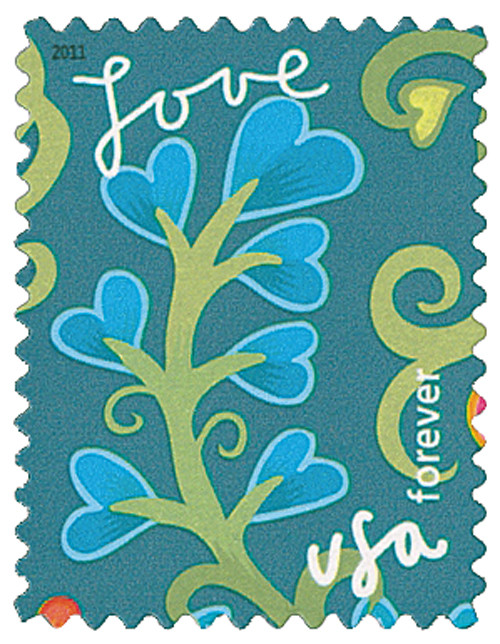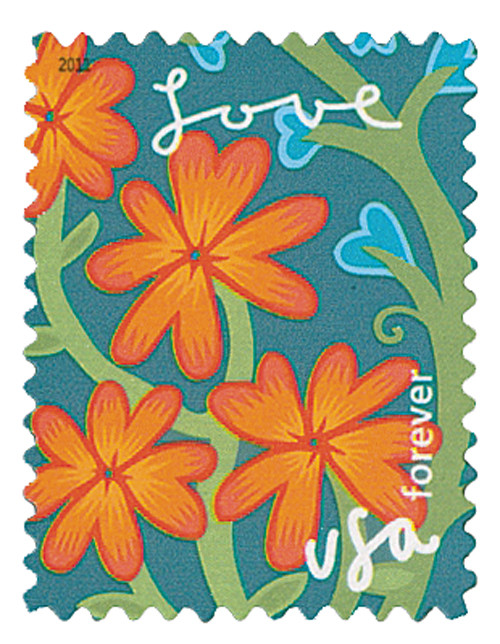
# 4536 - 2011 First-Class Forever Stamp - Garden of Love: Blue Flower
U.S. #4536
2011 44¢ Blue Flower
Garden of Love
Issue Date: May 23, 2011
City: Crestwood KY
Quantity: 300,000,000
Printed By: Avery Dennison
Printing Method: Photogravure
Color: multicolored
Over the last 4,000 years, gardens around the world have evolved from private resorts for the privileged, to the meeting place of royal courts, to places of serene contemplation for all who seek such relaxation.
Egyptian tomb paintings from the 1500s B.C. show some of the earliest recorded gardens. They featured lotus ponds surrounded by symmetrical rows of acacia and palm plants. The Persian gardens of around 800 B.C. depended on the soft, cool qualities of water to contrast the hot, dry climate of Iran.
The finest of the Egyptian gardens were lined with protective trees and had decorative pools with fish and birds. Gardens in Ancient Rome were places of peace and tranquility, a place to escape urban life. During the Byzantine Era (330-1453 A.D.), gardens were strongly influenced by the events of the time – largely, the adoption of Christianity as the official religion.
In Medieval years, gardens were seen as a place where the earth and divine united, while the gardens of the Renaissance walked visitors through a story as told by the owner, with statues and water features carrying references to mythology. Gardens of the 1700s embraced the natural landscapes for their wild, untamed qualities. Those of the 1800s were smaller and focused more on botanical curiosities.
Some modern gardens may feature elements of any or all of those that came before. Most contemporary gardens are inspired by modern architecture and the philosophy of “form following function.” Whether classic or modern, the gardens of the world are places where people can escape the stress of everyday life and appreciate the beauty and peace of nature.
U.S. #4536
2011 44¢ Blue Flower
Garden of Love
Issue Date: May 23, 2011
City: Crestwood KY
Quantity: 300,000,000
Printed By: Avery Dennison
Printing Method: Photogravure
Color: multicolored
Over the last 4,000 years, gardens around the world have evolved from private resorts for the privileged, to the meeting place of royal courts, to places of serene contemplation for all who seek such relaxation.
Egyptian tomb paintings from the 1500s B.C. show some of the earliest recorded gardens. They featured lotus ponds surrounded by symmetrical rows of acacia and palm plants. The Persian gardens of around 800 B.C. depended on the soft, cool qualities of water to contrast the hot, dry climate of Iran.
The finest of the Egyptian gardens were lined with protective trees and had decorative pools with fish and birds. Gardens in Ancient Rome were places of peace and tranquility, a place to escape urban life. During the Byzantine Era (330-1453 A.D.), gardens were strongly influenced by the events of the time – largely, the adoption of Christianity as the official religion.
In Medieval years, gardens were seen as a place where the earth and divine united, while the gardens of the Renaissance walked visitors through a story as told by the owner, with statues and water features carrying references to mythology. Gardens of the 1700s embraced the natural landscapes for their wild, untamed qualities. Those of the 1800s were smaller and focused more on botanical curiosities.
Some modern gardens may feature elements of any or all of those that came before. Most contemporary gardens are inspired by modern architecture and the philosophy of “form following function.” Whether classic or modern, the gardens of the world are places where people can escape the stress of everyday life and appreciate the beauty and peace of nature.















